As an Amazon Associate I earn from qualifying purchases.
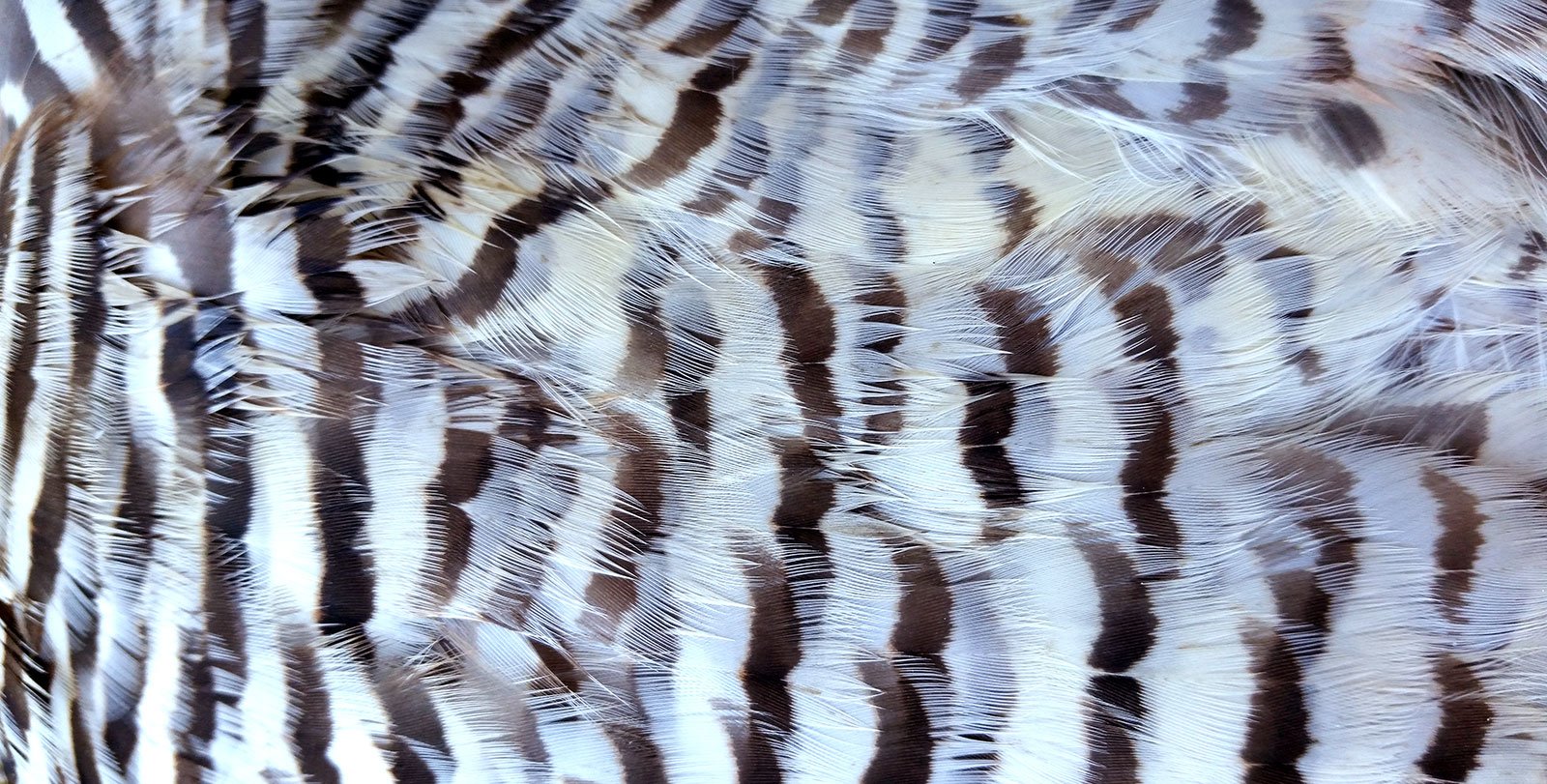
I’d miscalculated.
Four hours into my drive from Nebraska, with still more than an hour to go before I reached the ranch, I realized that flying into Omaha instead of Sioux Falls wasn’t my smartest move. The first few hours were through farmland, neat and tidy in the way that Upper Midwest farms are. Corn, wheat, alfalfa, soybeans. Shelter belts. Lines of trees planted as windbreaks. Pheasant country.
Finally, as I neared the Missouri River, the land changed. It began to roll gently, then moreso as the great river neared. Farms began to sprawl and blend into swathes of prairie, looking like relics of an earlier time. Ranching started to show itself. This looked better.
Not that I really knew what I was looking at. I know what sharp-tailed grouse like, and that’s short-grass prairie, scrubby hillsides and drainages. I just guessed that what I was driving so far to seek, the greater prairie chicken, would like the same places, more or less.
Prairie chickens. Visions of these Great Plains grouse had been dancing and booming in my head for weeks. I’d never seen one, shot one, or eaten one, but I’d heard so much about them.
Tympanuchus cupido was once as iconic an American bird as the turkey is now. Legendary at the table, prairie chicken was one of the meals Mark Twain pined for when stuck on an extended trip to Europe. It’s been said that Twain based the character Jim from Huckleberry Finn on a waiter who was so impressed that Twain had ordered an entire prairie chicken that he sat down and began a conversation with the author.
Millions of chickens were once shipped via railroad to the markets of Chicago, New York and elsewhere. Prairie chicken recipes were in all the cookbooks of the age. The bonanza seemed endless. Until it wasn’t. Even after the era of market hunting ended in 1918, the prairie chicken continued to struggle.
It still does, although there are an estimated 460,000 birds still living their chicken lives, mostly in a compact range stretching from eastern North Dakota down to central South Dakota, south through Nebraska and into Kansas. A few minor, “museum” populations hang on in Illinois, Oklahoma, Colorado, Missouri, Minnesota and Wisconsin.
Hunting is still allowed in North and South Dakota, Nebraska and Kansas. There’s a lottery for a hunt in Minnesota, too.
This hunt would close a circle for me, of sorts. If I were to shoot a chicken, it would mark a “sorta” Grand Slam of Grouse; I’d still need only the rock and willow ptarmigan. But that wasn’t terribly important to me. What I wanted most of all was to see these birds where they’re still strong, to hunt them, and, hopefully, to eat a slice of history.
I can hear some of you: Why on earth would you want to eat a bird that’s listed as “vulnerable” by the IUCN? Why indeed?
The answer isn’t that hard to understand. First, they are legal game in several states, which means there are enough to hunt without hurting the population. Second, no one eats prairie chicken as a major part of his diet anymore; the bag limit is three birds, and you need to walk long, shoot well, and enjoy a bit of luck to get those three. Third, this hunt was part of a gathering of the North American Grouse Partnership, a group dedicated to protecting the habitat for open-country grouse everywhere.
Finally, well… I’ll admit I just really wanted to see for myself what this bird was like up close and personal.
You see, a prairie chicken is not a sharpie. Sharp-tailed grouse live alongside prairie chickens, and are the only Great Plains grouse doing fine. I’ve shot them, on and off, for years. They are a dark-meat grouse, with very dark-meat breasts, but lighter legs, like all open-country grouse. They are full-flavored, and I like them, but many do not.
Not so with a chicken. Virtually everyone I’d talked to waxed rhapsodic about eating prairie chickens. Light meat, they swooned! Sure, darker than a ruffed grouse or pheasant, but a quantum difference from a sharpie. This I had to experience for myself.
I arrived at the lodge of Quenton and Toni McEntee, who run Traxx Hunting. We’d soon be joined by members of the Grouse Partnership, Ed Arnett of the Theodore Roosevelt Conservation Partnership, Howard Vincent of Pheasants Forever, a representative from the English shotgun maker Purdy, grouse biologists, and a higher-up in the South Dakota’s Game, Fish & Parks Dept. Heavy hitters all.
We’d split into groups to hunt with an assortment of small Münsterländer pointers, pudelpointers, a couple of Labs. As it happened, I was paired with fellow Californian Andrew Bogan and his dad; Bogan the Younger sits on the Grouse Partnership’s board of directors. Fog greeted us as we gathered ourselves in the morning.
It never ceases to amaze me how long it can take upland hunters to get ready to hunt. As a duck hunter, I am used to early mornings, discomfort, rushing to places. None of this applies to the upland world, where breakfast, chatter and one more cup of coffee before heading out is the rule. It takes some getting used to.
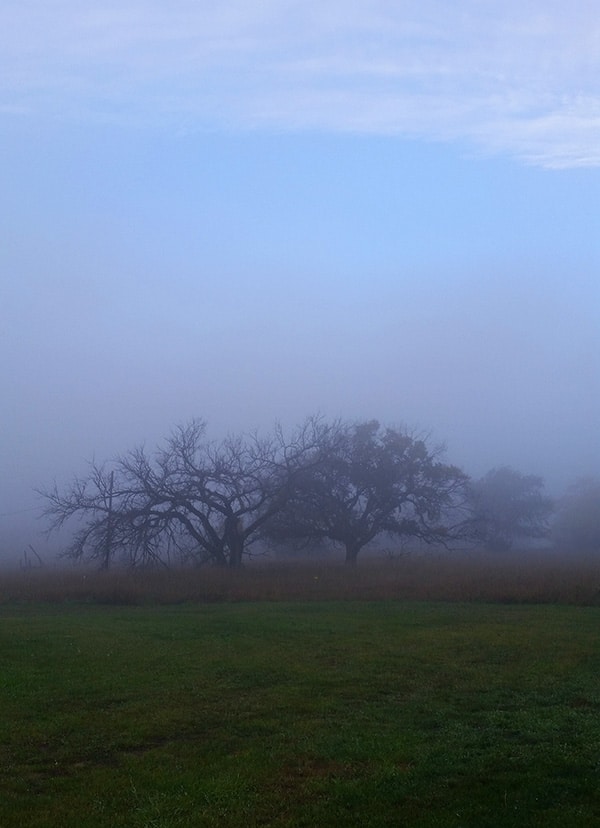
Fog, apparently, isn’t the best conditions for chicken hunting. The birds get damp and hunker down until they can find some sun to warm up and dry off in. My jeans and boots got soaked wandering up and down rolling hills and pastures, through snowberries and rose hips, native bunch grasses, coneflowers, alfalfa, and corn. Lots of corn.
This is where I got my first lesson in prairie chicken habitat.
Chickens evolved in symbiosis with bison in the tall-grass prairies of the Great Plains. The chickens relied on grazing to keep the grass short, and relished the various insects that swarmed bison droppings. They lived in decent numbers this way for eons, until agriculture showed up in the 1800s.
Unexpectedly, the chickens welcomed the initial intrusion of agriculture. A patchwork of farms, especially those growing corn and wheat, nestled among native prairie becomes a prairie chicken paradise. In Illinois, where this first happened in Chickenland, numbers exploded. This pattern extended all over the upper Midwest. An Iowa market hunter Richard Harker remembers:
We made some great chicken hunts from here to Clay County. We used to kill most of our chickens in the cornfields; four of us going abreast, jumping them. We used to leave early in the morning and go south into Clay County and leave the next day for home in the spring buggy we had. We used to kill enough chickens to fill our buggy and we often had to hold our dogs in our laps. We used to kill possibly two hundred chickens and they were just piled up in the wagon. We used to make these trips twice or three times a week and we always killed just as many as we could hold in our buggy.
Harker’s hunts were was about 245 miles from where we were walking, but the entire region served as the wild chicken coop for America’s cities. Before the boom, in 1821, a pair of chickens sold for the astonishing price of $5 in New York — that’s $91.50 in today’s dollars. Andrew Beahrs, in his book Twain’s Feast, posits that this may be because the New York market was suffering the loss of the eastern prairie chicken, known as the heath hen; it went officially extinct in the 1930s.
Once the boom hit, prices dropped considerably. A New York Times article in 1879 lists a pair of prairie chickens at $1.10, about $28.75 in today’s dollars. By way of comparison, that’s a good price for a pair of modern pastured chickens.
But as more prairie fell under the plow, the chickens took a header. It seems they like visiting a grain farm, but need their native prairie to rest, breed and nest. Predictably in the face of massive market hunting and habitat loss, the population began crashing. By 1907, the New York Times was reporting that a pair of chickens were fetching $4.50, a whopping $117.50 in today’s dollars.
Soon it was all over. Fortunately, states and then the federal government banned market hunting, but the habitat damage was more severe. With no more chickens to chase, states began looking at other birds — notably the ringneck pheasant. Pheasants, natives to China, were first introduced to the United States in Oregon in 1881 as a lark. They did so well there was a hunting season on them as early as 1892.
With this knowledge, one former chicken state after another began importing ringnecks. Illinois, arguably the epicenter of the prairie chicken boom, began introducing pheasants as a replacement in 1890. Iowa, where the chicken hunter Harker had his heyday, began stocking pheasants in 1900.
Pheasants like rough farms, the kind with shelter belts of scrubby grass and shrubs around them. Chickens and their sharpie cousins need wilder places.
We walked through those wilder places all that day, through some habitat that was perfect, some less so. We even hid in a cut cornfield to see if we could pass shoot a few birds flying into the corn for an evening meal before roosting.
In the end, we had only four chickens to show for it, and a biologist named Terry Riley managed to shoot his limit of three. Riley is in a growing list of sexagenarian upland hunters I’ve met who are making for some excellent role models: Wiry, tireless, predatory, fitter than I am by far. And I was among the fittest of our group, having just chased grouse all over Wyoming and Colorado. But Terry, who lives in Colorado, left me in the dust. Life goals.
Back at the lodge, I was tired, foot sore and a bit discouraged as I pulled on a bottle of Grain Belt. I was aching for a clean shot at one of these birds, but all day I’d either been in the wrong place when they flew, or the birds had just flushed 100-plus yards away. Frustrating.
The next day broke clear and cool. We again split up, and Quenton made sure I was in a group liable to find chickens; Andrew and the other group went off in search of sharpies.
We spread out eight men across in a cut corn field that transitioned into well cropped prairie grasses. Almost immediately, a chicken flushed. Unlike sage grouse and sharpies, which cluck as they fly off, these chickens made little or no sound other than the flushing of wings. They fly every bit as fast as a ruffed grouse, which, to my mind, is the fleetest and most agile of all grouse. But chickens tend to fly straight away, which is to their disadvantage.
Another hunter named Wayne dropped that bird. We were on the board! Elation soon ebbed, however, as the hours and miles began to pile up. I began to think I’d need to pay more penance before I’d get a chance at a chicken.
Beyond the next field, the land sloped down into a gentle draw choked with rose hips and snowberries. I casually began gathering rose hips, which I know to be a favorite food of prairie chickens. This really looked more like pheasant country. Dense, tight. Hard to walk through.
One of the Münsterländers locked up on point. My friend Nick Lowrey, who was writing an article on the hunt for the Pierre Capital Journal, stopped to shoot the picture of a pretty dog on a pretty point. Surely this was a pheasant — a bird out of season.
It flushed. Nick was gobsmacked. He stammered, “GROUSE!!!” I saw it off to my left, streaking away like a hen pheasant. Only it had a square tail and wasn’t clucking. I reached out, tracked the bird, led it a country mile, fired… and watched it shudder, set its wings and drop about 200 yards away. Another hunter named Steve rushed over to pick it up.
My first chicken! I was walking on clouds when Nick warned me, “there’s likely to be…”
Another chicken flushed, closer this time. I shot. It fell.
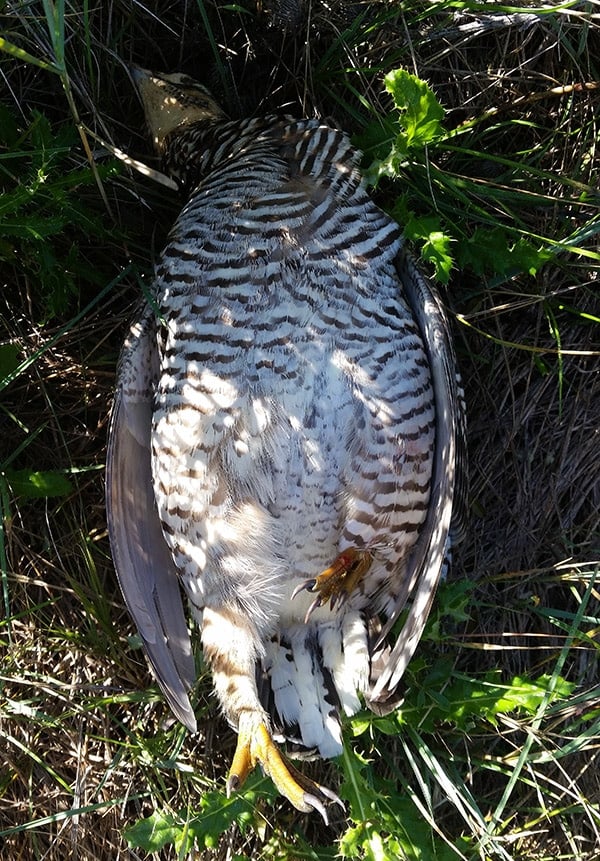
Finally I got a close look at a prairie chicken, a bird I’d chased like Ahab all these years.
The first thing I noticed is how boxy they are. Stocky in the way a bluebill duck is compared to a mallard. They certainly had the grouse clan’s jaunty crest and snubby beak. And those eyebrows! Cartoonish, canary eyebrows that make them look oh-so-serious. Across the breast nothing but rows and rows of black-and-white bars, giving them the look of an 19th century jailbird. By comparison, sharpies have largely white breasts, topped with that cryptic, leaf-like pattern all birds who hide for a living possess.
The rest of the hunt passed as in a dream.
Walking through a pasture among cattle, a sharpie flushed behind me and to my left, clucking all the way. Without thought, I lifted the gun, swung past Wayne, and when I was clear, dropped the bird with one shot. He shot the other, doing the same.
With Steve in possession of the first grouse I hit, I still had one more bird to bag for a limit. Chance, our guide, suggested we swing through a huge alfalfa field, where we might locate a flock of chickens that had flushed wild in front of the other hunters in our group earlier.
Larks, which had been our constant companions all weekend, flushed right and left. The sun warmed, lifting the grassy, sweet aroma of alfalfa. I held the outside right side of our column as we marched toward the dirt road that meant the end of the morning’s hunt. There would be no afternoon hunt for me, as I’d be cooking grouse for everyone that night.
No matter. Two birds in hand gave me enough to work with. One more rise, a barbed wire fence, and the road and we’re done.
BRRRRRRRRRRRR! A chicken flushed directly on the other side of the wire! BRRRRRRRRRRRRRRRRR! Another! This one I was ready for, and I dropped it. “Those are grouse!” I shouted, and Wayne and Chance each managed to get one.
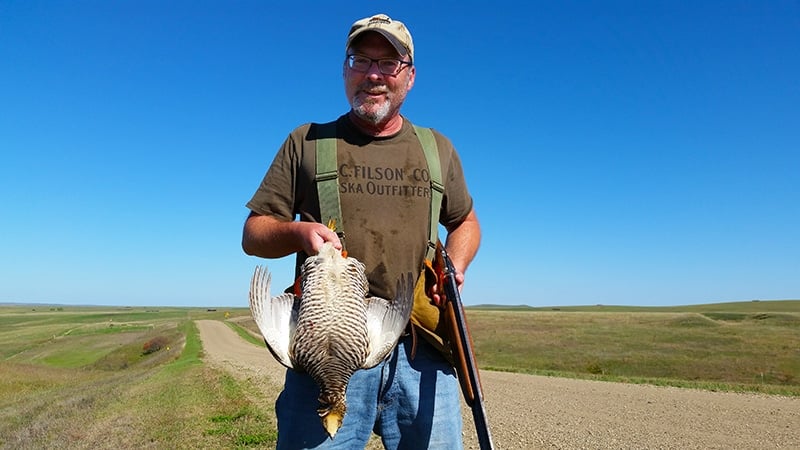
A limit. Maybe in the darkest corner of my inner fantasyland I imagined myself shooting a limit, but I’d laughed off any conscious contemplation of that. But here it was. And, as it happened, not only had I scored a limit, but so did Wayne and Ed from the Theodore Roosevelt Partnership.
All of a sudden, we were flush with chickens! Enough to cook for everyone that night — I ended up making a German-style braise with homemade morel mushroom spätzle — plus a few birds to take home even. More on those soon.

That night, over braised prairie chicken, prairie chicken breasts seared medium-rare, spätzle and beer and wine, we all talked about what we can do to not only preserve what prairie chickens have now, but to make things better.
For the most part, it’s up to private landowners. Most prairie chicken habitat is in private hands. Farmers like seeing the chickens around, but they have a bottom line to mind. This is where Farm Bill incentives like the Conservation Reserve Program or even private investment comes into play. Non-profits like the Grouse Partners, Pheasants Forever and the Theodore Roosevelt Partnership all add their bit to the effort.
So what can I do, or you? Lend your voice to any of these groups, and speak out when those remaining tracts of public prairie, like the Fort Pierre National Grasslands, come under threat. As hunters, we take birds from the land. We owe it to the land to give back, in whatever way we can. It’s the least we can do.


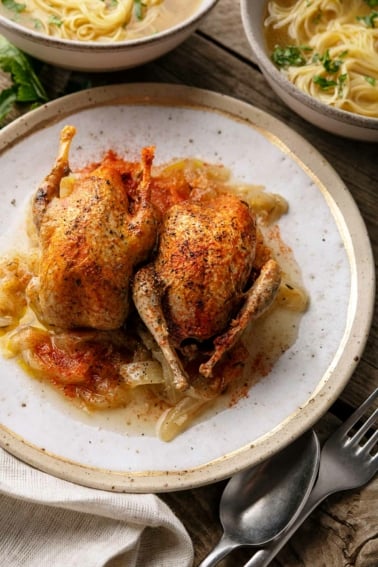
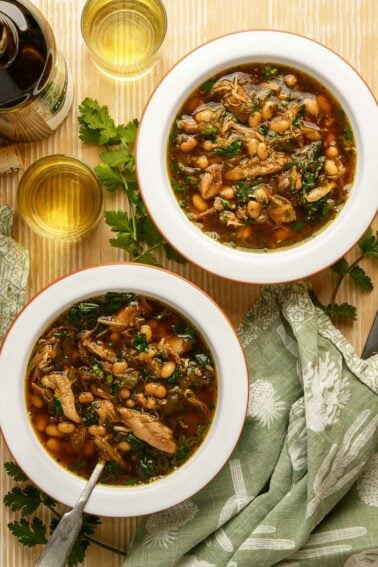
Thanks again for joining the North American Grouse Partnership in Iona, South Dakota this fall. Your ongoing efforts in support of upland bird conservation are much appreciated and it’s terrific to see so many preparations for grouse on the site. Grouse are delicious and beautiful birds that deserve more attention from hunters and conservationists across the continent.
Sad we missed you in the area! We live North if the Dam and love your books! They are never put away this time of year! ???